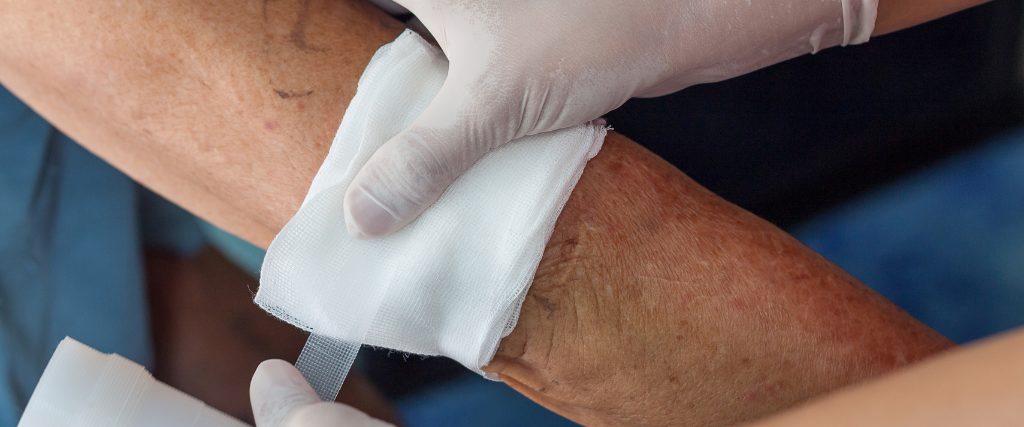



To receive important alerts and updates from Gold Coast Primary Health Network, please submit the form below.
"*" indicates required fields

To receive important alerts and updates from Gold Coast Primary Health Network, please submit the form below.

Two of the nation’s leading wound care specialists say poorly managed diabetes is costing Australia billions of dollars each year – and, they say, much of the damage is avoidable.
Bundall Medical Centre GP and chronic wound specialist Dr Stephen Yelland, and vascular specialist nurse practitioner Nicola Morley, say type 2 diabetes is a preventable disease, yet too many people continue to develop chronic wounds due to poor management and a lack of education.
“If you have arterial disease, the mortality rate is above that of prostate cancer and breast cancer,” Nicola said
“If you’re a type 2 diabetic, it’s a preventable disease, and we should be looking at prevention rather than the treatment of wounds.
“But what we are unfortunately seeing are the implications of chronic wounds across Australia – extended lengths of stays in hospital, loss of limbs, the pain and suffering and social isolation.
“For instance, for some patients, just the bandages alone can cost $300 a week, so it’s a massive financial burden that too few people outside of the healthcare system realise, and that sort of cost can lead to patients delaying care,” she said.
Chronic wounds are wounds that do not progress through the normal stages of healing within 30 days; they heal slowly, often only partially, and may recur.
Dr Yelland says better diabetes management and foot care could dramatically reduce the number of ulcers, amputations, and deaths.
“It’s that simple: save a limb, save a life and the reality is the severity of so many of these wounds are preventable.
“We recently had a case where a patient’s surgeon wanted to amputate his leg, but we worked on and with him twice a week and saved the limb and effectively his life.
“All of us working in wound management know the most important thing is the diagnosis about why that wound is there and then we can treat the underlying problem; that’s our job as doctors and nurses,” he said.
In May 2025, the Australian Government introduced the Chronic Wound Consumables Scheme (CWCS), covering the cost of wound care consumables for older Australians with diabetes and chronic wounds.
Recipients include people aged 65 and over- or First Nations people aged 50 and over- who are living with diabetes and a chronic wound.
The scheme fully covers essential items such as dressings, bandages, and adhesives to support healing.
“Nicola and I are very happy to see that the lobbying efforts of several organisations such as Wounds Australia are beginning to show some success,” Dr Yelland said.
“There’s still the need for greater general practitioner education, nurse education, and the training of GP registrars and medical students,” Dr Yelland said.
“They generally don’t get a lot of education and skills in this area and that’s one thing we continue to work on with the Gold Coast Primary Health Network (GCPHN) which funds an education program that’s been very successful for a few years now.
“There’s no other model like it anywhere else in Australia, where a PHN funds both a chronic wounds clinic in primary care and education programs.
“The GCPHN certainly deserves a lot of credit for the work they’ve done to fund the education programs and other initiatives.
“Possibly the biggest takeaway for the participants is that we explain how we sit with our patients and listen to them and how most times we can detect what is wrong simply from what they tell us.
“A lot of the time we can do a diagnosis even before we look at the wound just by talking to the patient, which a machine can’t do,” he said.
Nicola agrees the human touch is essential.
Palpation is crucial in enabling diagnostics such as arterial disease, rather than use machines that deliver a reading without the ability to look at the root causes.
“Stephen and I live by the old medical school adage; listen to the patient, take their history and then do the examination,” she said.
People wanting more information on the GCPHN wounds management training workshops can visit: Wound Management Training for Nurses in Primary Care – Gold Coast Primary Health Network
| Mikalia McMillian – Robina Town Medical Centre
“It’s been extremely helpful and exceeded my expectations. “I’d recommend it to any new nurses starting in general practice as well as those who have been in general practice for a while.” |
Erin Barnes – Robina Town Medical Centre
“I’d recommend it to our GPs and our clinics as the doctor [friendly] version of wound education; it brings it back to basics. “When we diagnose what is going wrong with a patient, we can sometimes be swept up with how to fix the wound rather than figuring out and understanding the underlying condition. “It would definitely be worth the GPs going through this course with the treatment room nurses, particularly when it comes to preparing care plans.” |
So we can provide you with the most accurate information,
please tell us a little more about yourself

